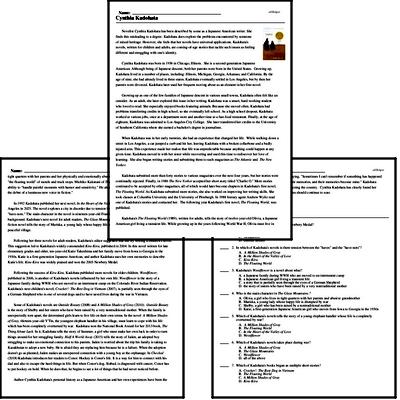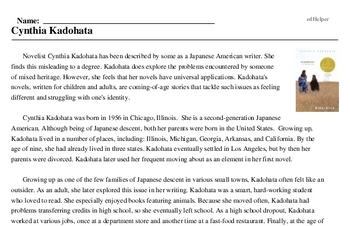Cynthia Kadohata
Novelist Cynthia Kadohata has been described by some as a Japanese American writer. She finds this misleading to a degree. Kadohata does explore the problems encountered by someone of mixed heritage. However, she feels that her novels have universal applications. Kadohata's novels, written for children and adults, are coming-of-age stories that tackle such issues as feeling different and struggling with one's identity.
Cynthia Kadohata was born in 1956 in Chicago, Illinois. She is a second-generation Japanese American. Although being of Japanese descent, both her parents were born in the United States. Growing up, Kadohata lived in a number of places, including: Illinois, Michigan, Georgia, Arkansas, and California. By the age of nine, she had already lived in three states. Kadohata eventually settled in Los Angeles, but by then her parents were divorced. Kadohata later used her frequent moving about as an element in her first novel.
Growing up as one of the few families of Japanese descent in various small towns, Kadohata often felt like an outsider. As an adult, she later explored this issue in her writing. Kadohata was a smart, hard-working student who loved to read. She especially enjoyed books featuring animals. Because she moved often, Kadohata had problems transferring credits in high school, so she eventually left school. As a high school dropout, Kadohata worked at various jobs, once at a department store and another time at a fast-food restaurant. Finally, at the age of eighteen, Kadohata was admitted to Los Angeles City College. She later transferred her credits to the University of Southern California where she earned a bachelor's degree in journalism.
When Kadohata was in her early twenties, she had an experience that changed her life. While walking down a street in Los Angeles, a car jumped a curb and hit her, leaving Kadohata with a broken collarbone and a badly injured arm. This experience made her realize that life was unpredictable because anything could happen at any given time. Kadohata moved in with her sister while recovering and used this time to rediscover her love of learning. She also began writing stories and submitting them to such magazines as The Atlantic and The New Yorker.




